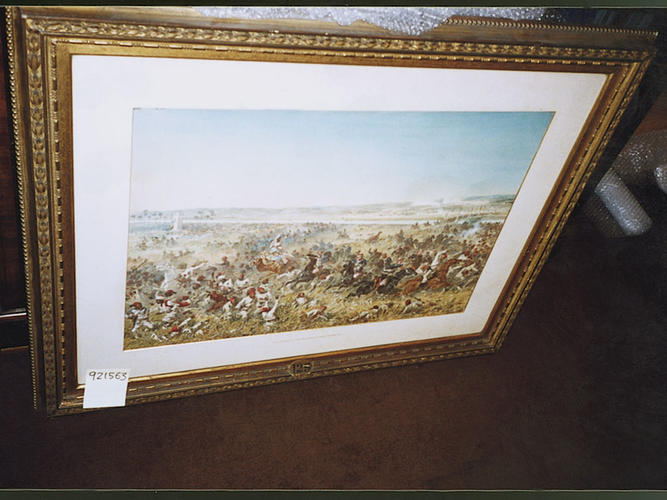-
1 of 253523 objects
The battle of Tel-el-Kebir, Second Anglo-Egyptian War, 13 September 1882 c.1882-3
82.0 x 104.0 cm (frame, external) | RCIN 921563
-
A watercolour depicting an extensive battle scene, with British cavalry charging at Egyptian infantry from the right. Signed: Orlando Norie.
This watercolour shows British troops engaged in what was an early dawn attack on their Egyptian opponents. The Battle of Tel-el-Kebir took place in the desert on 13 September 1882; the timing of the British attack, led by Sir Garnet Wolseley, was intended to give them the upper hand in a difficult military situation, as any daytime advance would have been easily spotted by the Egyptian army who were camped in the desert and had prepared defences there. The Egyptian army was led by Urābī Pasha; the British won the battle and marched on Cairo to capture Pasha, who was ultimately exiled to Ceylon (Sri Lanka). Queen Victoria’s third son Prince Arthur, Duke of Connaught, an army officer, took part in the engagement in command of the Guards Brigade.
The 1870s saw a period of deteriorating relations between the British Empire and Egypt amid a developing Egyptian nationalist movement discontented with external intervention in the country’s infrastructure and operation. Following riots in Alexandria on Egypt’s Mediterranean coast, where British and French naval forces were already present, in July 1882 the British launched a naval bombardment of the city and went on to seize the Suez Canal. The Suez Canal, which had opened in 1869, was of significant strategic interest to Britain as it offered a new and considerably shorter route to India. After several smaller conflicts, the Battle of Tel-el-Kebir on 13 September 1882 resulted in the British taking power in Egypt, though ostensibly it was an independent country ruled by the Khedive (Viceroy). Egypt became a British protectorate in 1914 and was then granted nominal independence by the British in 1922; the Republic of Egypt was declared in 1953.
Orlando Norie was born into a well-known Scottish artistic family but spent much of his working life in France. He is particularly known as a painter of military scenes, and had a long-lasting professional relationship with the printsellers and publishers Ackermann & Co who managed his picture sales and published lithographs after his drawings, beginning with scenes of Crimean battles in the 1850s. He is not thought to have travelled outside of Europe, and therefore his scenes of colonial military action are not personal eye-witness accounts. The significant group (c.70) of watercolours by Norie now in the Royal Collection primarily came from two sources - Queen Victoria, via purchase or commission, and at least eighteen which were previously in the collection of Prince Arthur and given to the Royal Collection after his death in 1942. -
Creator(s)
-
Medium and techniques
Measurements
82.0 x 104.0 cm (frame, external)
51.0 x 73.0 cm (sight)
Category
Object type(s)
Subject(s)
Other number(s)
RL 21563
